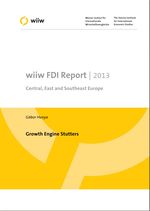Growth Engine Stutters
Gabor Hunya and Monika Schwarzhappel
wiiw FDI Report No. 2013-06, June 2013
125 pages including 94 Tables, 8 Figures and 4 Boxes
Content
- The first part of the publication contains an analysis of the latest FDI trends.
The analysis highlights the modest recovery of FDI in 2012. - The second part of the publication contains two sets of tables:
- Tables I: total flow and stock data, FDI flow by components and FDI income, FDI per capita and other FDI reference parameter (2004-2012)
- Tables II: detailed FDI data by economic activity and by country (last four years)
The main sources of data are the central banks of the individual Central, East and Southeast European countries.
General Description
- General Description (PDF)
Abstract
The first part of this report provides an analysis of the 2012 FDI trends in 22 CESEE countries, pointing to a modest recovery. The strongest growth in inflows in 2012 was observed in the NMS (+35%) following a year with extremely low inflows. But the exceptionally high FDI inflow in the Czech Republic and Hungary was mainly the result of capital in transit and financial flows not resulting in fixed investments. The decline in the SEE countries was 22% following a relatively successful year and caused by a one-time capital withdrawal from Serbia. Inflows to the CIS remained flat (+1%) and were strongly biased upwards by round-tripping Russian capital. FDI inflows declined in twelve CESEE countries, in line with the generally depressed business sentiment and unimpressive economic growth. The latter is even more reflected in the low number of greenfield investment projects and in their small size. Forecasts for economic growth in 2013 and first quarter trends in FDI flows and greenfield projects suggest a serious setback of FDI in most CESEE countries, with the possible exceptions of Poland, Slovenia and Kazakhstan. As another main cause, it is expected that Russian companies will be more reluctant and also restricted to use Cyprus as a stepping stone for investments at home thus both the outflow and inflow of Russian FDI is expected to diminish.
The second part of this report contains two sets of tables: Tables I cover FDI flow and stock data, FDI flows by components and related income; Tables II provide detailed FDI data by economic activity and country. The main sources of data are the central banks of the individual Central, East and Southeast European countries.
The wiiw FDI Report is the new title of the former publication ‘wiiw Database on Foreign Direct Investment in Central, East and Southeast Europe’. The printed report and the analysis therein is based upon the wiiw FDI Database which will be available online from July 2013.
|
Examples
|
NEW SERVICE: The wiiw FDI Database is available online from July 2013
This new online access with a modern query tool supports easy search and download of data.
The wiiw FDI Database contains the full set of FDI data with time series starting form 1990 as far as available.
Access to wiiw FDI Database
Reference to wiiw databases: wiiw FDI Database
Keywords: foreign direct investment, balance of payments, income repatriation, statistics, new EU Member States, Southeast Europe, CIS
JEL classification: C82, F21, O57, P23
Countries covered: Albania, Belarus, Bosnia and Herzegovina, Bulgaria, CIS, Croatia, Czechia, Estonia, Hungary, Kazakhstan, Latvia, Lithuania, North Macedonia, Moldova, Montenegro, New EU Member States, Poland, Romania, Russia, SEE, Serbia, Slovakia, Slovenia, Turkey, Ukraine
Research Areas: International Trade, Competitiveness and FDI
